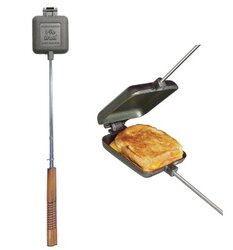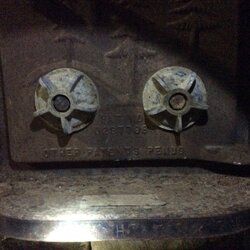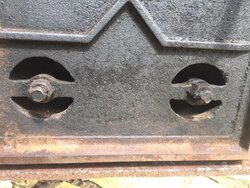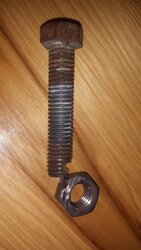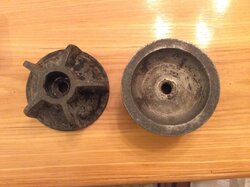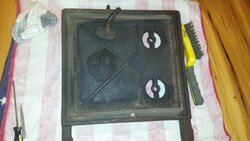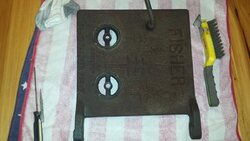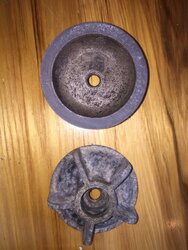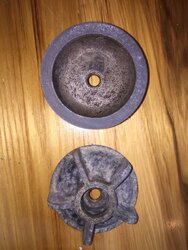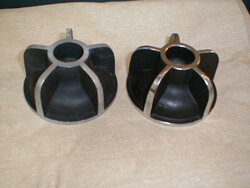Howdy,
I'm new to wood burning stoves, but have always wanted one. Two days ago I aquired a 1979 fisher Papa Bear at what I hope was a good deal ($100), in what seems to me to be in good shape (pictures below). It has two broken bricks and two whole ones that fell off the wall which I will fix shortly.
I have been browsing the forum for a few days trying to get to know what my interest in stoves was getting me in to and really appreciate the knowledge and community participation. I have gleamed plenty of information/ideas/how too from the multitude of posts.
What I am looking to start is a single thread which can put as many restoration tips in one thread as possible, anything you can think someone in my shoes might need to know or find useful. If this already exist I appologise. Please direct me to it? I know there are a lot of answers scattered around the forum and have found some, but thought everyone could benefit from a succinct restoration thread.
As for my Papa Bear VI;
I have already fixed the hinge pins (which were frozen and bent), unfroze the 5 fin vents, and fired it up for the first time in 21 years. I'm way too excited about this stove.
My plans for him (Papa Bear) is to instal a baffle (using Coaly's instructions), six feet of single wall pipe fixed to be free standing (attach to t-post?), refinish him, and use him outside (is this ok?) in our breakfast garden while I build an outdoor cooking area in which I'll use him (make cocoa, heat water etc...) I really want him to look brand new as I love the looks of the old guy, so here are some questions I could use help with, but please include anything you think will help a newbie.
What's the best way to remove/restore the air vent knobs?
What's the best rust removal method for the outside, is bicarbonate blasting any better than wire brush?
What is the best/most durable paint for the exterior surfaces?
Where can I find those fancy bear feet? Other parts?
Anyone have any tips for cooking on top of him?
What should be the exact deminsions for the baffle plate?
Anything interesting you can tell about him from the serial plate?
I appreciate the help, and hope I'm not restarting another thread.
And now, without further hoopla meet Papa Bear:
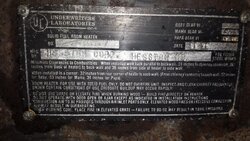
He was made in Hesston Kansas in November 1979, number F715419
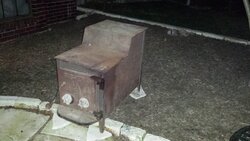
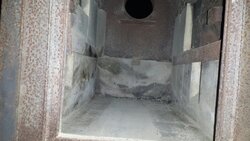
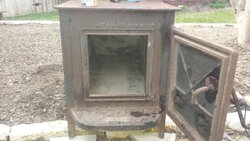
P.s. This is also the first forum I have ever joined so any constructive criticism is welcome.....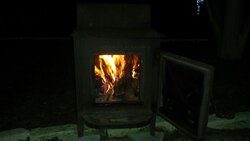
I'm new to wood burning stoves, but have always wanted one. Two days ago I aquired a 1979 fisher Papa Bear at what I hope was a good deal ($100), in what seems to me to be in good shape (pictures below). It has two broken bricks and two whole ones that fell off the wall which I will fix shortly.
I have been browsing the forum for a few days trying to get to know what my interest in stoves was getting me in to and really appreciate the knowledge and community participation. I have gleamed plenty of information/ideas/how too from the multitude of posts.
What I am looking to start is a single thread which can put as many restoration tips in one thread as possible, anything you can think someone in my shoes might need to know or find useful. If this already exist I appologise. Please direct me to it? I know there are a lot of answers scattered around the forum and have found some, but thought everyone could benefit from a succinct restoration thread.
As for my Papa Bear VI;
I have already fixed the hinge pins (which were frozen and bent), unfroze the 5 fin vents, and fired it up for the first time in 21 years. I'm way too excited about this stove.
My plans for him (Papa Bear) is to instal a baffle (using Coaly's instructions), six feet of single wall pipe fixed to be free standing (attach to t-post?), refinish him, and use him outside (is this ok?) in our breakfast garden while I build an outdoor cooking area in which I'll use him (make cocoa, heat water etc...) I really want him to look brand new as I love the looks of the old guy, so here are some questions I could use help with, but please include anything you think will help a newbie.
What's the best way to remove/restore the air vent knobs?
What's the best rust removal method for the outside, is bicarbonate blasting any better than wire brush?
What is the best/most durable paint for the exterior surfaces?
Where can I find those fancy bear feet? Other parts?
Anyone have any tips for cooking on top of him?
What should be the exact deminsions for the baffle plate?
Anything interesting you can tell about him from the serial plate?
I appreciate the help, and hope I'm not restarting another thread.
And now, without further hoopla meet Papa Bear:

He was made in Hesston Kansas in November 1979, number F715419



P.s. This is also the first forum I have ever joined so any constructive criticism is welcome.....



